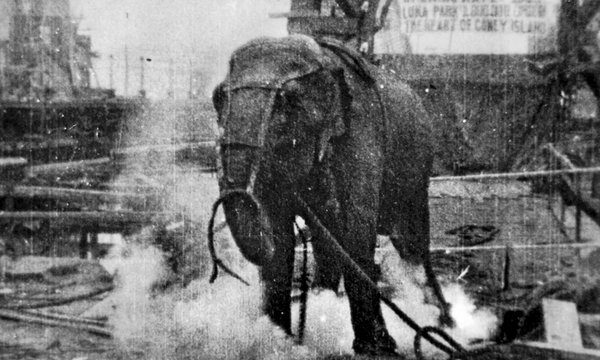Topsy the Elephant
 Topsy was in her late twenties when she was murdered at Luna Park on Coney Island in New York on January 4, 1903. The murder scene is one of America’s first theme parks at a time when the United States emerges as an industrial world leader. My use of the word “murder” rather than “killed” is deliberate. Her life and death represent the fate of many animals—not just elephants and not just in the entertainment industry. Even though some thought her guilty, I felt she was innocent. She attacked and killed people through no fault of her own. You can take wild animals out of the wild and believe they can be tamed. But you cannot take the wild out of a wild animal and make them tame. Even though she attacked and killed people, I believe she’s innocent of any guilty act. Topsy’s true crime, if indeed it was an offence, is to be an elephant. To be more precise, it’s to be guilty of being a wild-caught elephant held captive in a human-made environment unnatural for her kind. Why should we be surprised when elephants held against their will attack and kill people? Perhaps we should be surprised that they don’t do it more often. Should elephants like Topsy be held responsible for their actions when the human impact on their lives is the reason why they behave as they do?
Topsy was in her late twenties when she was murdered at Luna Park on Coney Island in New York on January 4, 1903. The murder scene is one of America’s first theme parks at a time when the United States emerges as an industrial world leader. My use of the word “murder” rather than “killed” is deliberate. Her life and death represent the fate of many animals—not just elephants and not just in the entertainment industry. Even though some thought her guilty, I felt she was innocent. She attacked and killed people through no fault of her own. You can take wild animals out of the wild and believe they can be tamed. But you cannot take the wild out of a wild animal and make them tame. Even though she attacked and killed people, I believe she’s innocent of any guilty act. Topsy’s true crime, if indeed it was an offence, is to be an elephant. To be more precise, it’s to be guilty of being a wild-caught elephant held captive in a human-made environment unnatural for her kind. Why should we be surprised when elephants held against their will attack and kill people? Perhaps we should be surprised that they don’t do it more often. Should elephants like Topsy be held responsible for their actions when the human impact on their lives is the reason why they behave as they do?
Today, we know elephants are intelligent, social animals with complex emotional, physiological, psychological, and behavioural lives. Each one is unique with an individual personality. In 1903, awareness about elephants and their needs was not as it is today. There were no elephant sanctuaries to shelter Topsy for the rest of her life. Instead, she’s sent to her death. Elephant deaths in the entertainment industry weren’t that unusual back then. Sadly, they’re not rare today either.

Read my chapter “Topsy: The Elephant We Must Not Forget” in Krebber, Andre and Mieke Roscher. 2018. Animal Biography: Re-framing Animal Lives. (London: Palgrave Macmillan.
To write the biography of any animal who lived more than 100 years ago is a challenge. But to write the biography of an elephant in which more is known about how and why she died than anything else about her life is particularly challenging. She only exists in our world because of what people wrote and filmed about her. If she had never been caught, abducted, and murdered and, instead, lived and died in the world in which she was born, we would never have known she existed. We only know about Topsy because her narrative was written as the “Man-killing elephant who had to be killed!” I can never right the wrong of Topsy’s life and death; but I can write her biography by rejecting the “man-killing myth” promoted by the newspapers at the time, and tell her true story informed by compassion, truth, and justice.











